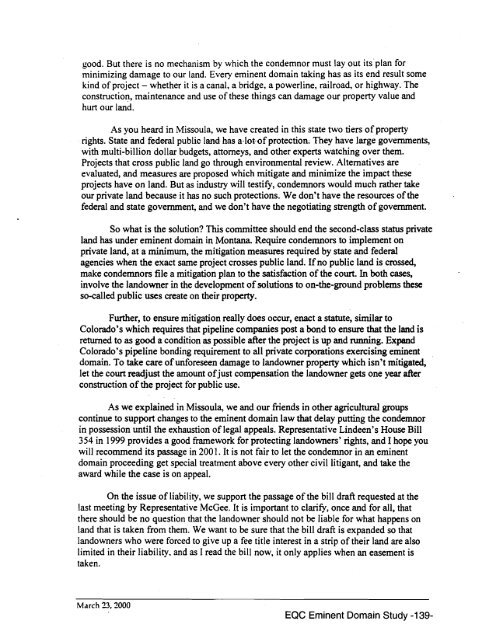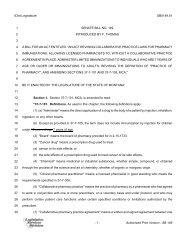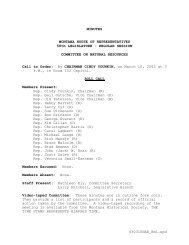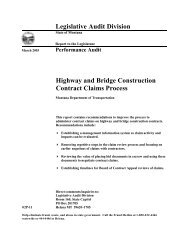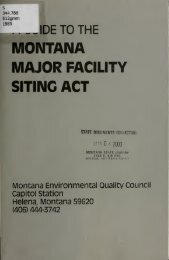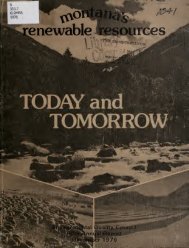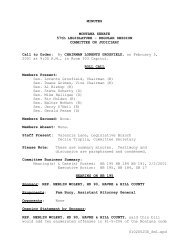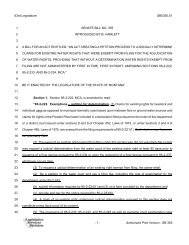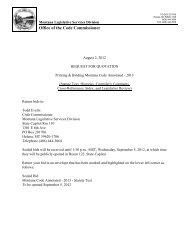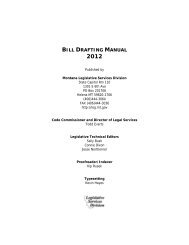Public Comment. Volume III - Montana Legislature
Public Comment. Volume III - Montana Legislature
Public Comment. Volume III - Montana Legislature
You also want an ePaper? Increase the reach of your titles
YUMPU automatically turns print PDFs into web optimized ePapers that Google loves.
good. But there is no mechanism by which the condemnor must lay out its'plan for<br />
minimizing damage to our land. Every eminent domain taking has as its end result some<br />
kind of project - whether it is a canal, a bridge, a powerline, railroad, or highway. The<br />
construction, maintenance and use of these things can damage our property value and<br />
hurt our land.<br />
As you heard in Missoula, we have created in this state two tiers of property<br />
rights. State and federal public land has a-lot-of protection. They have large governments,<br />
with multi-billion dollar budgets, attorneys, and other experts watching over them.<br />
Projects that cross public land go through environmental review. Alternatives are<br />
evaluated, and measures are proposed which mitigate and minimize the impact these<br />
projects have on land. But as industry will testify, condemnors would much rather take<br />
our private land because it has no such protections. We don't have the resources of the<br />
federal and state government, and we don't have the negotiating strength of government.<br />
So what is the solution? This committee should end the second-class status private<br />
land has under eminent domain in <strong>Montana</strong>. Require condemnors to implement on<br />
private land, at a minimum, the mitigation measures required by state and federal<br />
agencies when the exact same project crosses public land. If no public land is crossed,<br />
make condemnors file a mitigation plan to the satisfaction of the court. In both cases,<br />
involve the landowner in the development of solutions to on-the-ground problems these<br />
so-called public uses create on their property.<br />
Further, to ensure mitigation really does occur, enact a statute, similar to<br />
Colorado's which requires that pipeline companies post a bond to ensure that the land is<br />
returned to as good a condition as possible after the project is up and running. Expand<br />
Colorado's pipeline bonding requirement to all private corporations exercising eminent<br />
domain. To take care of unforeseen damage to landowner property which isn't mitigated,<br />
let the court readjust the amount of just compensation the landowner gets one year after<br />
construction of the project for public use.<br />
As we explained in Missoula, we and our friends in other agricultural groups<br />
continue to support changes to the eminent domain law that delay putting the condemnor<br />
in possession until the exhaustion of legal appeals. Representative Lindeen's House Bill<br />
354 in 1999 provides a good framework for protecting landowners' rights, and I hope you<br />
will recommend its passage in 200 1. It is not fair to let the condemnor in an eminent<br />
domain proceeding get special treatment above every other civil litigant, and take the<br />
award while the case is on appeal.<br />
On the issue of liability, we support the passage of the bill draft requested at the<br />
last meeting by Representative McGee. It is important to clarify, once and for all, that<br />
there should be no question that the landowner should not be liable for what happens on<br />
land that is taken from them. We want to be sure that the bill draft is expanded so that<br />
landowners who were forced to give up a fee title interest in a strip of their land are also<br />
limited in their liability. and as I read the bill now, it only applies when an easement is<br />
taken.<br />
March 23,2000<br />
EQC Eminent Domain Study -1 39-


